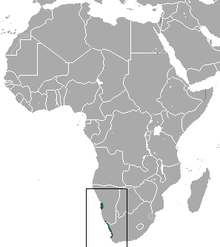Grant's golden mole
| Grant's golden mole | |
|---|---|
| Scientific classification | |
| Kingdom: | Animalia |
| Phylum: | Chordata |
| Class: | Mammalia |
| Order: | Afrosoricida |
| Family: | Chrysochloridae |
| Subfamily: | Chrysochlorinae |
| Genus: | Eremitalpa Roberts, 1924 |
| Species: | E. granti |
| Binomial name | |
| Eremitalpa granti (Broom, 1907) | |
| Subspecies | |
|
E. g. granti | |
 | |
| Grant's golden mole range | |
Grant's golden mole (Eremitalpa granti) is a golden mole species. It is the only member of its genus.
Attributes
Like all other golden moles the build of these animals is similar to the moles, though they are not related, and is adapted to a life of digging. The front extremities are remodeled to digging claws; in contrast to most other species of its family they have three claws each. The tail is physically not visible, there are no auricles, the eyes are covered with fur, and the mouth is bearing a leather-like pad, which also serves for digging.
Grant's golden mole has a long silky fur, which is colored gray on cubs and sandy on older animals. With a length of 7.5 to 9 cm and a weight of 15 to 25 g it is the smallest member of its species.
Geographical distribution and habitat
Grant's golden mole lives on the western coast of South Africa and in south western Namibia.[1] Its natural habitat is dry areas, mostly sandy deserts.[1]
Diet and social behaviour
In contrast to many other golden moles, Grant's golden mole rarely builds lasting tunnels. It "swims" through the sand just under or on the surface while searching for food. It is mainly a nocturnal animal, resting by day in small caves beneath sheltering plants.[1] It is a solitary animal, with stomping grounds averaging 4.6 ha.
Besides termites and other invertebrates, its diet consists of reptiles such as skinks.
Status of endangerment
Grant's golden mole is listed as near threatened (NT) by the IUCN.[1] It is a highly specialized species that is very sensitive to the destruction of its habitat.[1]
References
- 1 2 3 4 5 6 Bronner, G. (2008). "Eremitalpa granti". IUCN Red List of Threatened Species. Version 2008. International Union for Conservation of Nature. Retrieved 29 December 2008.
- Ronald M. Nowak: Walker's Mammals of the World. The Johns Hopkins University Press, Baltimore 1999, ISBN 0-8018-5789-9.
